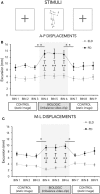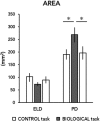Postural Stabilization Strategies to Motor Contagion Induced by Action Observation Are Impaired in Parkinson's Disease
- PMID: 29545771
- PMCID: PMC5837984
- DOI: 10.3389/fneur.2018.00105
Postural Stabilization Strategies to Motor Contagion Induced by Action Observation Are Impaired in Parkinson's Disease
Abstract
Postural reactions can be influenced by concomitant tasks or different contexts and are modulated by a higher order motor control. Recent studies investigated postural changes determined by motor contagion induced by action observation (chameleon effect) showing that observing a model in postural disequilibrium induces an increase in healthy subjects' body sway. Parkinson's disease (PD) is associated with postural instability and impairments in cognitively controlled balance tasks. However, no studies investigated if viewing postural imbalance might influence postural stability in PD and if patients are able to inhibit a visual postural perturbation. In this study, an action observation paradigm for assessing postural reaction to motor contagion in PD subjects and healthy older adults was used. Postural stability changes were measured during the observation of a static stimulus (control condition) and during a point-light display of a gymnast balancing on a rope (biological stimulus). Our results showed that, during the observation of the biological stimulus, sway area and antero-posterior and medio-lateral displacements of center of pressure significantly increased only in PD participants, whereas correct stabilization reactions were present in elderly subjects. These results demonstrate that PD leads to a decreased capacity to control automatic imitative tendencies induced by motor contagion. This behavior could be the consequence either of an inability to inhibit automatic imitative tendencies or of the cognitive load requested by the task. Whatever the case, the issue about the ability to inhibit automatic imitative tendencies could be crucial for PD patients since it might increase falls risk and injuries.
Keywords: Parkinson’s disease; action observation; biological motion; chameleon effect; motor contagion; postural stabilization strategies.
Figures



Similar articles
-
Does observation of postural imbalance induce a postural reaction?PLoS One. 2011 Mar 15;6(3):e17799. doi: 10.1371/journal.pone.0017799. PLoS One. 2011. PMID: 21423622 Free PMC article.
-
Do equilibrium constraints modulate postural reaction when viewing imbalance?Brain Cogn. 2012 Jul;79(2):89-95. doi: 10.1016/j.bandc.2012.02.008. Epub 2012 Mar 30. Brain Cogn. 2012. PMID: 22466502
-
Postural sway in patients with early Parkinson's disease performing cognitive tasks while standing.Neurol Res. 2018 Jun;40(6):491-498. doi: 10.1080/01616412.2018.1451017. Epub 2018 Jun 5. Neurol Res. 2018. PMID: 29869975
-
Action observation in the modification of postural sway and gait: Theory and use in rehabilitation.Gait Posture. 2017 Oct;58:115-120. doi: 10.1016/j.gaitpost.2017.07.113. Epub 2017 Jul 24. Gait Posture. 2017. PMID: 28772130 Review.
-
The Impact of Parkinson's Disease on Postural Control in Older People and How Sex can Mediate These Results: A Systematic Review.Geriatrics (Basel). 2021 Oct 29;6(4):105. doi: 10.3390/geriatrics6040105. Geriatrics (Basel). 2021. PMID: 34842716 Free PMC article. Review.
Cited by
-
Lower-Limb Exoskeletons for Gait Training in Parkinson's Disease: The State of the Art and Future Perspectives.Healthcare (Basel). 2024 Aug 16;12(16):1636. doi: 10.3390/healthcare12161636. Healthcare (Basel). 2024. PMID: 39201194 Free PMC article. Review.
-
Evaluation of Balance Disorders in Parkinson's Disease Using Simple Diagnostic Tests-Not So Simple to Choose.Front Neurol. 2018 Oct 31;9:932. doi: 10.3389/fneur.2018.00932. eCollection 2018. Front Neurol. 2018. PMID: 30429825 Free PMC article. Review.
-
Visibly constraining an agent modulates observers' automatic false-belief tracking.Sci Rep. 2020 Jul 9;10(1):11311. doi: 10.1038/s41598-020-68240-7. Sci Rep. 2020. PMID: 32647240 Free PMC article.
-
Dominance of attentional focus: a comparative study on its impact on standing postural control in healthy younger and older adults.Front Hum Neurosci. 2024 Jun 26;18:1384305. doi: 10.3389/fnhum.2024.1384305. eCollection 2024. Front Hum Neurosci. 2024. PMID: 38988825 Free PMC article.
-
Motor Resonance Flexibility to Emotion-Enriched Context in Parkinson's Disease Patients.Behav Neurol. 2022 Dec 30;2022:6487419. doi: 10.1155/2022/6487419. eCollection 2022. Behav Neurol. 2022. PMID: 36755906 Free PMC article.
References
LinkOut - more resources
Full Text Sources
Other Literature Sources

